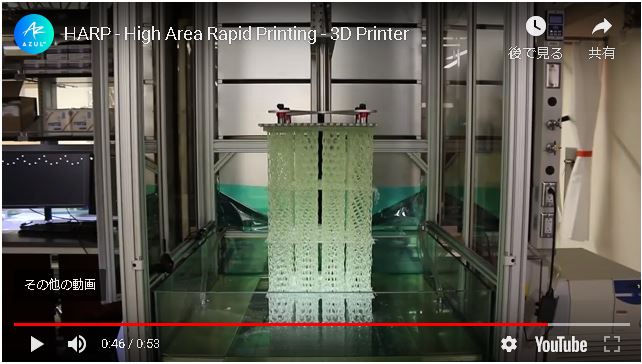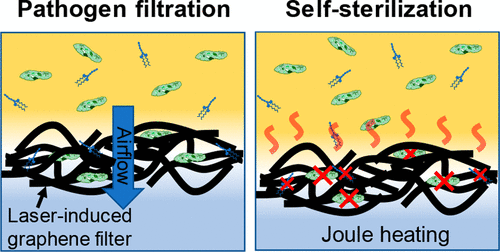(Highest-throughput 3D printer is future of manufacturing)
2019/10/17 アメリカ合衆国・ノースウェスタン大学

・ ノースウェスタン大学が、大型のオブジェクトを僅か数時間で作製できる、大型で超高速の先進的な新型 3D プリンター、HARP(high-area rapid printing)(特許出願中)を開発。18 ヶ月以内の商業化を見込んでいる。
・ 同 3D プリンター技術は、過去 30 年間の積層造形技術開発における大型パーツ製造の速度、スループットと解像度の課題を解決。オンデマンドによる製品製造の記録的なスループットを可能にする。・ HARP は、液体樹脂を固体プラスチックに転換するステレオリソグラフィータイプの 3D プリンティング技術。垂直方向にプリントして紫外線照射で液体樹脂を硬化させる。同プロセスでは、硬質・弾性部品やセラミック部品も作製できる。・ プリント作製した部品は他の3D プリント技術による標準的な層状構造に比して機械的強度に優れ、 HARP の高解像度光パターニングにより、部品のプリント作製後、マシニング等の追加工が不要。・ HARP のプロトタイプは、高さ 13 フィート(約 4m)、プリントベッドが 2.5 スクエアフット(約 0.2 ㎡)で、半ヤード(約 46cm)のオブジェクトを 1 時間以内にプリントする。これは 3D プリントでは記録的なスループットであり、大型部品や様々な小型部品の一括プリントや大量バッチ製造が可能となる。・ 樹脂をベースとした現在の 3D プリンターでは、時に 180℃を超えるほどの、高速プリント時の発熱の課題がある。これは危険な表面温度につながるだけでなく、プリント部品のき裂や変形の原因にもなる。プリント速度が上がるとプリンターの発熱量も増加するため、大型プリンターの発熱は極めて高温となる。・ 高速 3D プリンティング時に樹脂の重合反応による発熱を拡散させる方法がないことから、3D プリンティング関連企業は小規模となっている。・ 同大学は、液体のテフロンのような挙動をする不粘着性の液体を透過窓から流し入れ、熱を除去してから冷却ユニットで循環させることでこの課題を解決。透過窓を通じて光を照射し、垂直に移動するプレート上の樹脂を硬化させる HARP は他の技術と同様に発熱するが、それを除去するインタフェースを取り入れた。・ テフロン液の不粘着性により、プリンターへの樹脂の貼り付きを回避することでプリントバットの底部より繰り返しプリント部品を引きはがす必要がなくなることから、プリンターの速度が 100 倍向上。・ HARP の研究開発を率いた、世界的に有名なナノテクノロジー分野の専門家である Chad A. Mirkin 博士は、微細なペンでナノスケール形状をパターニングする世界最小のプリンターの dip-pen nanolithography を 1999 年に開発。HARP の不粘着性インターフェースは、その後のナノスケール 3D プリンターの研究開発において考案したもの。 URL: https://news.northwestern.edu/stories/2019/10/biggest-fastest-3d-printer-is-future-ofmanufacturing/ (関連情報) Science 掲載論文(アブストラクトのみ:全文は有料) Rapid, large-volume, thermally controlled 3D printing using a mobile liquid interface URL: https://science.sciencemag.org/content/366/6463/360
<NEDO海外技術情報より>
Large-scale, continuous 3D printing
Many three-dimensional (3D) printing methods build up structures layer by layer, which causes a lamination layer between each discrete step. Continuous printing can be done from a fluid bed if a so-called dead layer is used to buffer between the solidified structure and pool of resin. However, printing speeds are limited by the heat buildup from the exothermic polymerization process, thus limiting the ultimate size of the printed object. Walker et al. use a pumped, nonreactive fluorinated oil to act as the dead layer that removes heat during polymerization. This approach allows for both speedup and scale-up of the printing process.
Science, this issue p. 360
Abstract
We report a stereolithographic three-dimensional printing approach for polymeric components that uses a mobile liquid interface (a fluorinated oil) to reduce the adhesive forces between the interface and the printed object, thereby allowing for a continuous and rapid print process, regardless of polymeric precursor. The bed area is not size-restricted by thermal limitations because the flowing oil enables direct cooling across the entire print area. Continuous vertical print rates exceeding 430 millimeters per hour with a volumetric throughput of 100 liters per hour have been demonstrated, and proof-of-concept structures made from hard plastics, ceramic precursors, and elastomers have been printed.



